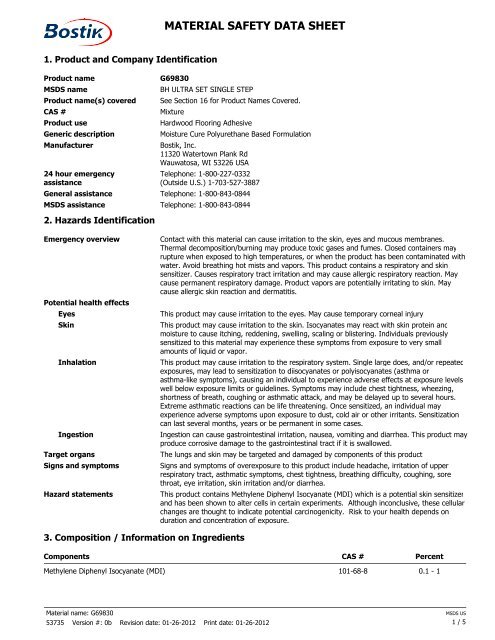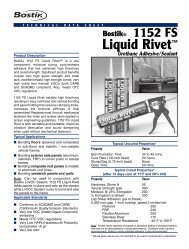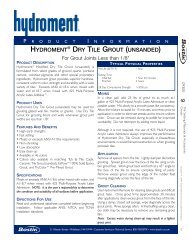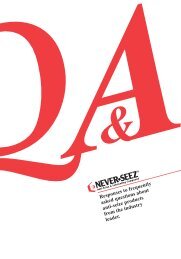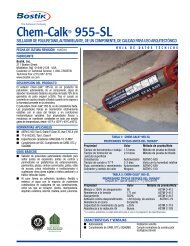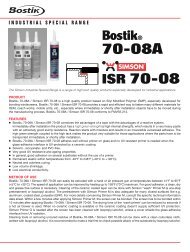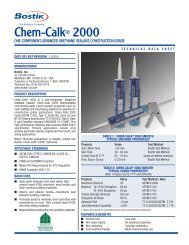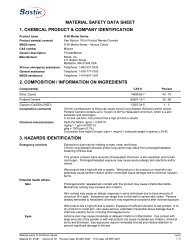bh ultra set single step msds
bh ultra set single step msds
bh ultra set single step msds
Create successful ePaper yourself
Turn your PDF publications into a flip-book with our unique Google optimized e-Paper software.
.4. First Aid MeasuresspaceFirst aid proceduresspacespacespacespaceEye contactSkin contactInhalationIngestionNotes to physicianImmediately flush eyes with plenty of water for at least 15 minutes. Get medical attention oradvice.For skin contact flush with large amounts of water while removing contaminated clothing. Ifskin irritation persists, call a physician. For severe exposure, immediately get under a safetyshower and begin rinsing.If inhaled, immediately remove the affected person to fresh air. Call a physician if symptomsdevelop or persist. Administer oxygen or artificial respiration as needed.If the material is swallowed, get immediate medical attention or advice. Do not induce vomitingwithout medical advice. Never give anything by mouth to a victim who is unconscious or ishaving convulsions.Provide general supportive measures and treat symptomatically. Contact Bostik to determinewhether any additional information is available. Eyes: Stain for evidence of corneal injury. Ifcornea is burned, apply antibiotic/steroid preparation as needed. Skin: This product contains askin sensitizer. Treat symptomatically as for contact dermatitis or thermal burn. Ingestion:Treat symptomatically. Inhalation: This material contains a known pulmonary sensitizer. Anyindividual experiencing dermal or pulmonary sensitization should be removed from exposure toany diisocyanate. May aggravate existing heart conditions, particularly those with abnormalheart rhythms..5. Fire Fighting MeasuresspaceHazardous combustionproductsspaceExtinguishing mediaspaceSuitable extinguishingmediaFire fightingequipment/instructionsspaceFlash pointUpon decomposition, this product emits carbon monoxide, carbon dioxide and/or lowmolecular weight hydrocarbons. Additional decomposition products include oxides of nitrogen,amines, hydrogen cyanide and isocyanate-containing compounds.Dry chemical, foam, carbon dioxide, water fog.Firefighters should wear full protective clothing including self contained breathing apparatus.Avoid contact with isocyanates. During a fire, isocyanate vapors and other irritating and highlytoxic gases may be produced.> 200 °F (> 93.3 °C).6. Accidental Release MeasuresspaceEmergency actionspaceSpill or leak procedurespaceContainment proceduresspaceReportingWear appropriate personal protective equipment. Do not allow product to enter sewer orwaterways. Follow all Local, State, Federal and Provencial regulations for disposal. Regulationsvary. Consult local authorities before disposal.Scrape up material and place in steel drums that are in good condition. Thoroughly clean areawhere spill occurred. Remove sources of ignition. Ventilate area of spill.Isolate spill area. Stop discharge if safe to do so. Stop material from contaminating soil orfrom entering sewers or water streams. Liquid spills: Cover spills with absorbent clay orsawdust and collect material in open container and neutralize with a solution containing 2%liquid detergent, 3% concentrated ammonium hydroxide and 95% water. Wash spill areaclean with the neutralization solution. Remove container to a safe place, cover loosely andallow to stand for 24 to 48 hours letting evolved carbon dioxide escape. Collect and containfor disposal.Pellet or chip spill: Collect and contain for salvage or disposal. Molten adhesive spill: Placardhot material, allow to cool and remove. If material is not cured once cooled, followneutralization directions for liquids listed above. Collect and contain for disposal.See Federal reporting requirements listed in Section 15. We recommend you contact localauthorities to determine if there may be other local reporting requirements.Material name: G6983053735 Version #: 0b Revision date: 01-26-2012 Print date: 01-26-2012MSDS US2 / 5
.7. Handling and StoragespaceHandlingspaceStoragespaceEmpty container precautionDo not get this material in your eyes, on your skin, or on your clothing. Wash hands afterhandling and before eating. Do not breathe gas/fumes/vapor/spray. Wear respiratoryprotection if the material is heated, sprayed, used in a confined space or if exposure limit isexceeded. This product can produce asthmatic sensitization. Individuals with lung or breathingproblems or prior allergic reactions to isocyanates must avoid fumes from this product. Wearappropriate protective equipment to avoid contact with skin and eyes.Keep in a dry, cool and well-ventilated place. Keep away from heat. Keep away from directsunlight. Do not handle or store near an open flame, heat or other sources of ignition.Attention! Follow label warnings even after container is emptied since empty containers mayretain product residues. Do not reuse empty container without professional cleaning for food,clothing, or products for human or animal consumption, or where skin contact can occur..8. Exposure Controls / Personal ProtectionspaceEngineering controlsspacePersonal protective equipmentspacespacespaceGeneralspaceEye protectionSkin and body protectionRespiratory protectionAdditional exposure dataProvide local and general exhaust ventilation to effectively remove and prevent buildup of anyvapors or mists generated from the handling of this product. Explosion proof exhaustventilation should be used.Wear safety glasses with side shields.Use impervious gloves. Work clothing sufficient to prevent all skin contact should be worn,such as coveralls and long sleeves.Avoid breathing vapor and/or mists. If airborne concentrations are above the applicableexposure limits, use NIOSH approved respiratory protection. High airborne concentrations maynecessitate the use of self-contained breathing apparatus (SCBA) or a supplied air respirator.Eyewash fountains and emergency showers should be readily available.US ACGIH Threshold Limit Values: Time Weighted Average (TWA): mg/m3 & ppmMethylene Diphenyl Isocyanate 101-68-8 METHYLENE BISPHENYL ISOCYANATE (MDI) 0.005 PPM(MDI)US NIOSH Pocket Guide to Chemical Hazards: Ceiling Limit Value and Time Period (if specified)Methylene Diphenyl Isocyanate(MDI)101-68-8.9. Physical & Chemical PropertiesspaceTarget solids 96.8 %spacepHspaceDensityspaceOdorspaceColorspacePhysical statespaceFreeze protectspaceVOC (Volatile OrganicCompounds)N/A1.645 g/ccMildBeigePasteNo0 g/l.10. Chemical Stability & Reactivity InformationMETHYLENE BISPHENYL ISOCYANATE 0.2 MGM3 - 0.020 PPM 10-minspaceHazardousreactions/decompositionproductsspaceHazardous polymerizationspaceConditions to avoidspaceStabilityUpon decomposition, this product emits carbon monoxide, carbon dioxide and/or lowmolecular weight hydrocarbons. Additional decomposition products include oxides of nitrogen,amines, hydrogen cyanide and isocyanate-containing compounds.Hazardous polymerization can occur with elevated temperatures or contact with water.Avoid Strong Acids. Avoid amines, strong bases, alcohols and metallic hydrides. Keep awayfrom sources of ignition.This product is stable under normal conditions but will react slightly with water to release someheat and carbon dioxide. The reaction is not violent. Carbon dioxide, carbon monoxide and inhigh temperature (800° F) low oxygen atmospheres such as in fire situations, hydrogencyanide may be released.Material name: G6983053735 Version #: 0b Revision date: 01-26-2012 Print date: 01-26-2012MSDS US3 / 5
.11. Toxicological InformationspaceCarcinogenicityspaceLocal effectsIf this product contains any carcinogens, they will be noted below: This product containsMethylene Diphenyl Isocyanate (MDI). MDI is not listed by the NTP, IARC or regulated byOSHA as a carcinogen. However, it has been shown to alter cells in certain experiments.Although inconclusive, these cellular changes are thought to indicate potential carcinogenicity.Single large does, and/or repeated exposures, may lead to sensitization to diisocyanates orpolyisocyanates (asthma or asthma-like symptoms), causing an individual to experienceadverse effects at exposure levels well below exposure limits or guidelines. Symptoms mayinclude chest tightness, wheezing, shortness of breath, coughing or asthmatic attack, and maybe delayed up to several hours. Extreme asthmatic reactions can be life threatening. Oncesensitized, an individual may experience adverse symptoms upon exposure to dust, cold air orother irritants. Sensitization can last several months, years or be permanent in some cases.Chronic exposure may cause lung damage, including fibrosis and decreased lung function,which may be permanent..12. Ecological InformationspaceEcotoxicological informationNo data available for this product..13. Disposal ConsiderationsspaceIt is the obligation of each user of the product mentioned herein to determine and comply with the requirements of all applicablelocal, state and federal regulations.spaceWaste disposal.14. Transport InformationspaceDOTspaceIATAspaceIMDGNot regulated as hazardous goods.Not regulated as hazardous goods.Not regulated as hazardous goods..15. Regulatory InformationspaceDispose of waste material according to Local, State, Federal, and Provincial EnvironmentalRegulations. Wastes must be tested using methods described in 40 CFR Part 261 to determineif it meets applicable definitions of hazardous wastes. Empty containers must be handled withcare due to product residue. Do not heat or cut empty container with electric or gas torch.This MSDS is prepared and distributed pursuant to the Federal Hazard Communication Standard, 29 CFR 1910.1200.The product(s) covered by this (M)SDS do not include any of the substances above a concentration of 0.1% weight by weight(w/w) in the Candidate List of Substances of Very High Concern (SVHC) for authorization published or proposed by ECHA on thefollowing dates:-October 28, 2008- August 31, 2009- January 13, 2010- March 8, 2010- June 18, 2010- October 14, 2010- December 15, 2010- June 20, 2011- December 19, 2011spaceFederal regulationsspaceAll components are on the U.S. EPA TSCA Inventory List.US EPCRA (SARA Title III) Section 313 - Toxic Chemical: Listed substanceMethylene Diphenyl Isocyanate(MDI)State regulations101-68-8METHYLENEBIS(PHENYLISOCYANATE) (MDI) US EPCRA (SARA Title III) Section 313 -Toxic Chemical: Listed substanceIf this product contains any California Proposition 65 chemicals at reportable levels they will belisted below:Butyl Benzyl Phthalate (BBP)Di-Isodecyl Phthalate (DIDP)Material name: G6983053735 Version #: 0b Revision date: 01-26-2012 Print date: 01-26-2012MSDS US4 / 5
spaceInternational regulationsspaceHMIS Ratings Health: 2*Flammability: 1Physical hazard: 0Personal protection: XspaceSARA 311/312 HAZARDCATEGORIESspaceWHMIS statusspaceWHMIS labelingThis product has been classified in accordance with the hazard criteria of the ControlledProducts Regulations and contains all the information required by the Controlled ProductsRegulations.Immediate Hazard - YesDelayed Hazard - YesFire Hazard - NoPressure Hazard - NoReactivity Hazard - NoControlledspaceWHMIS classificationD2A - Other Toxic Effects-VERY TOXIC.16. Other InformationspaceDisclaimerspaceFurther informationspaceIssue date 01/26/2012spacePrepared byspaceSupercedes 06/27/2011spaceThis data sheet containschanges from the previousversion in section(s):The data in this MSDS has been compiled from publicly available sources. This data relatesonly to the designated product and not to the use of said product in combination with othermaterials. All materials may present unknown hazards and should be used with caution.Although certain hazards are described herein, we cannot guarantee that these are the onlyhazards which exist. Responsibility for proper precautions and safe use of the product lies withthe user. All data in this MSDS is typical of the product as a whole, and does not represent anyindividual lot or batch, therefore, Bostik, Inc. makes no warranty about the accuracy of thedata herein and assumes no liability for the use of such data. It is the responsibility of the userto comply with all applicable federal, state, and local laws and regulations.Any characters following " G69830 " are just designations for the various types of packagingthat are available for this product. These characters do not indicate a different product nor adifferent regulatory, health, safety and/or environmental status. This document covers theG69830 for all of its packaging types.Bostik, Inc. Regulatory AffairsRegulatory Information: International regulationsRegulatory Information: Default StatementsMaterial name: G6983053735 Version #: 0b Revision date: 01-26-2012 Print date: 01-26-2012MSDS US5 / 5


